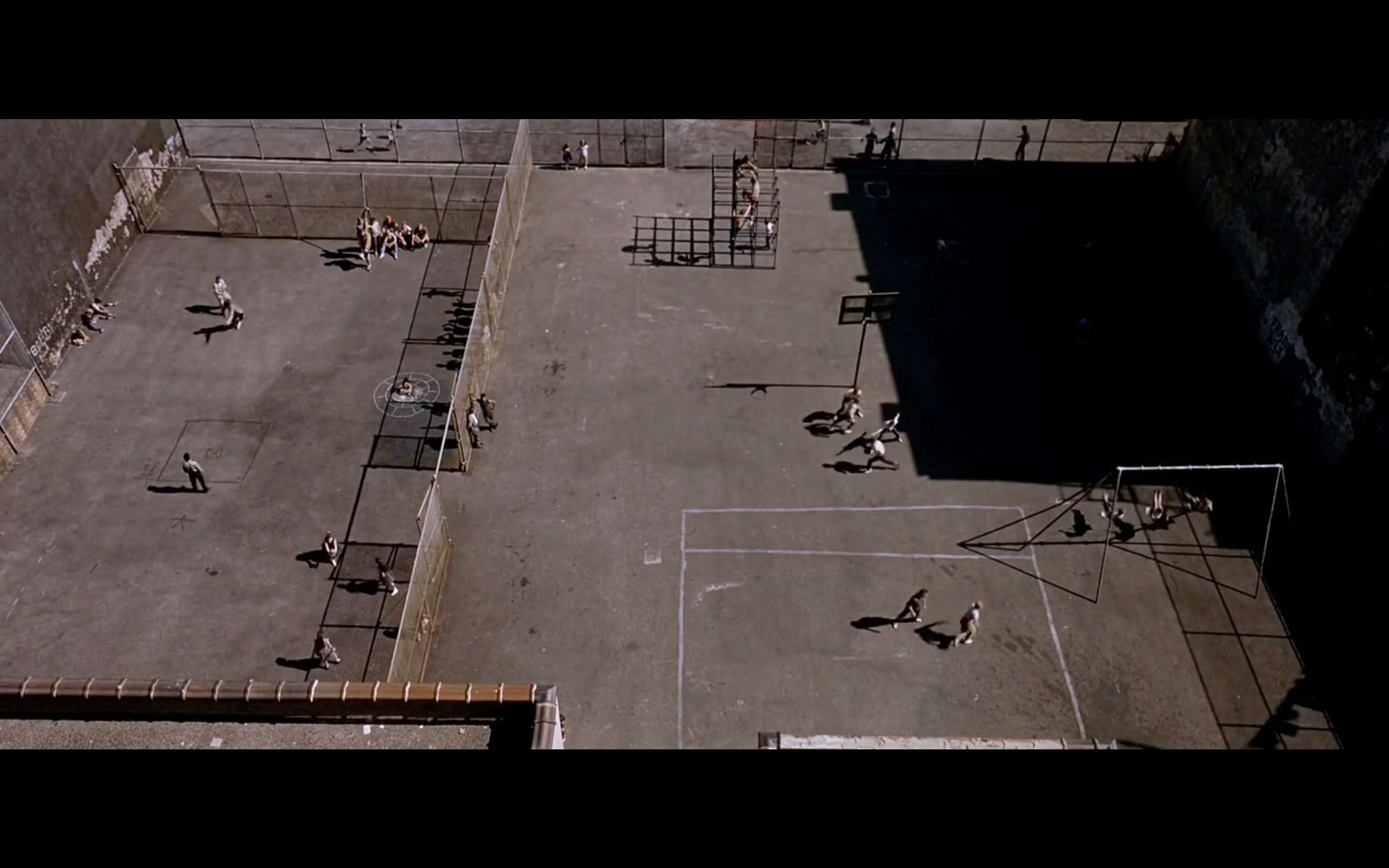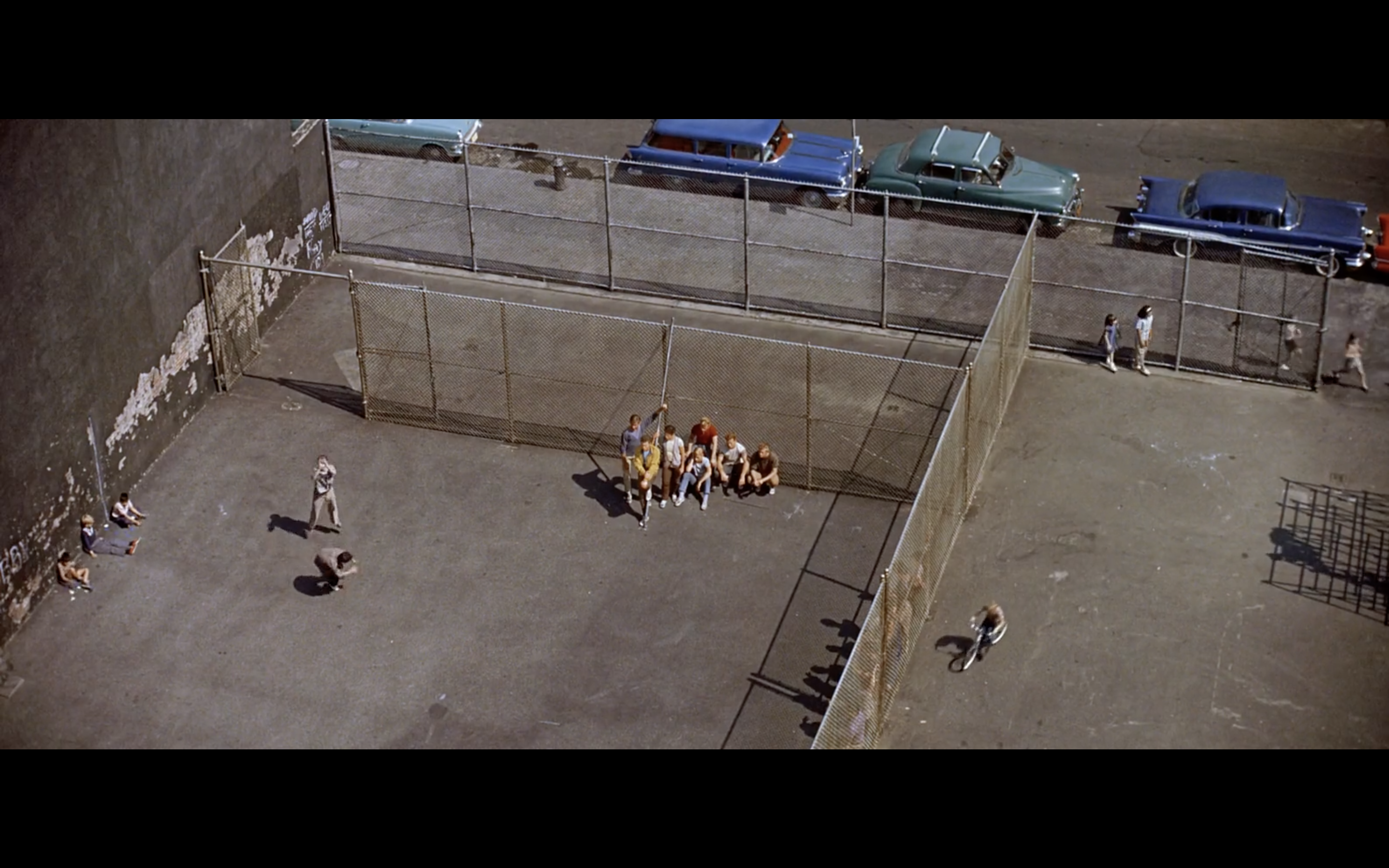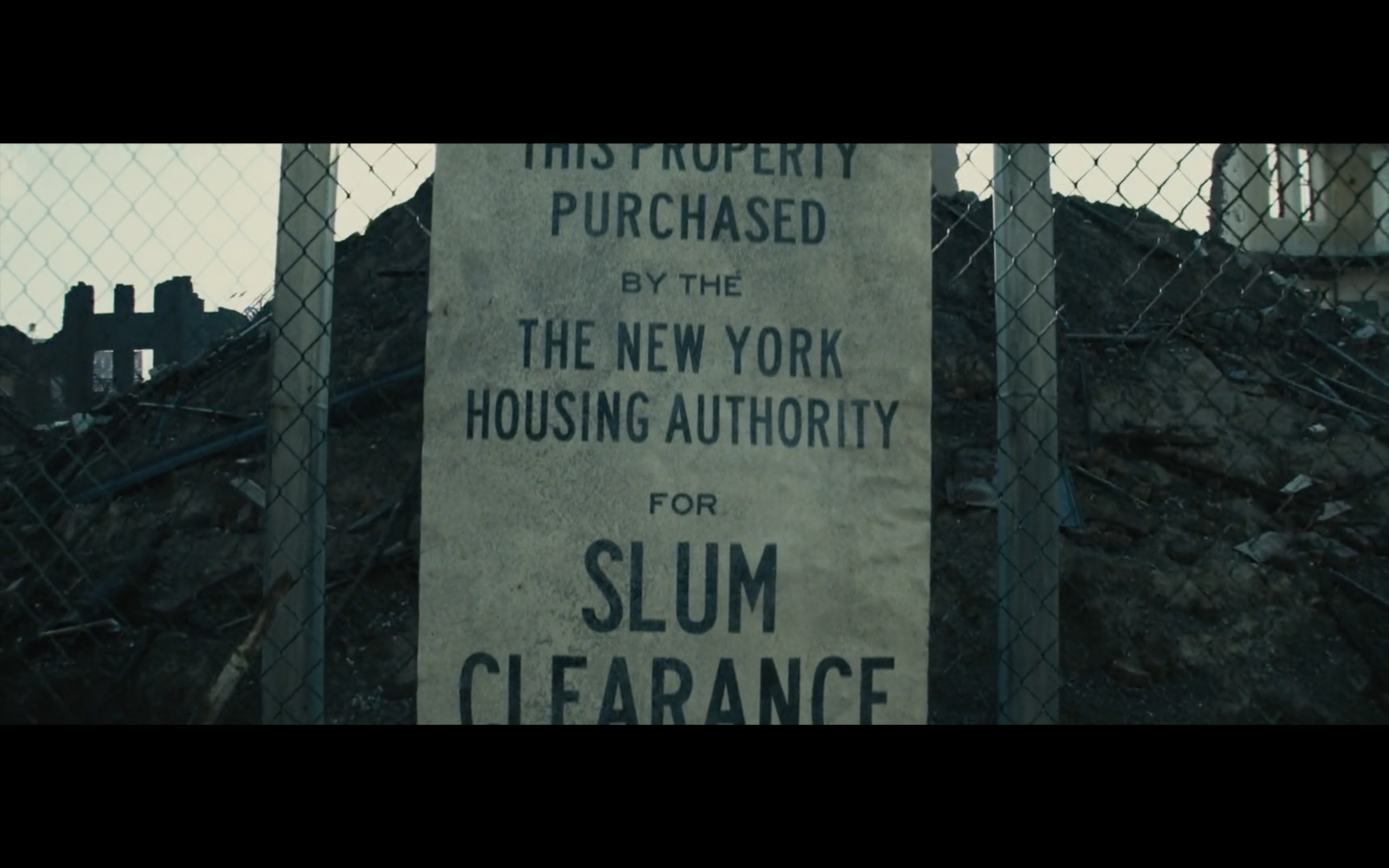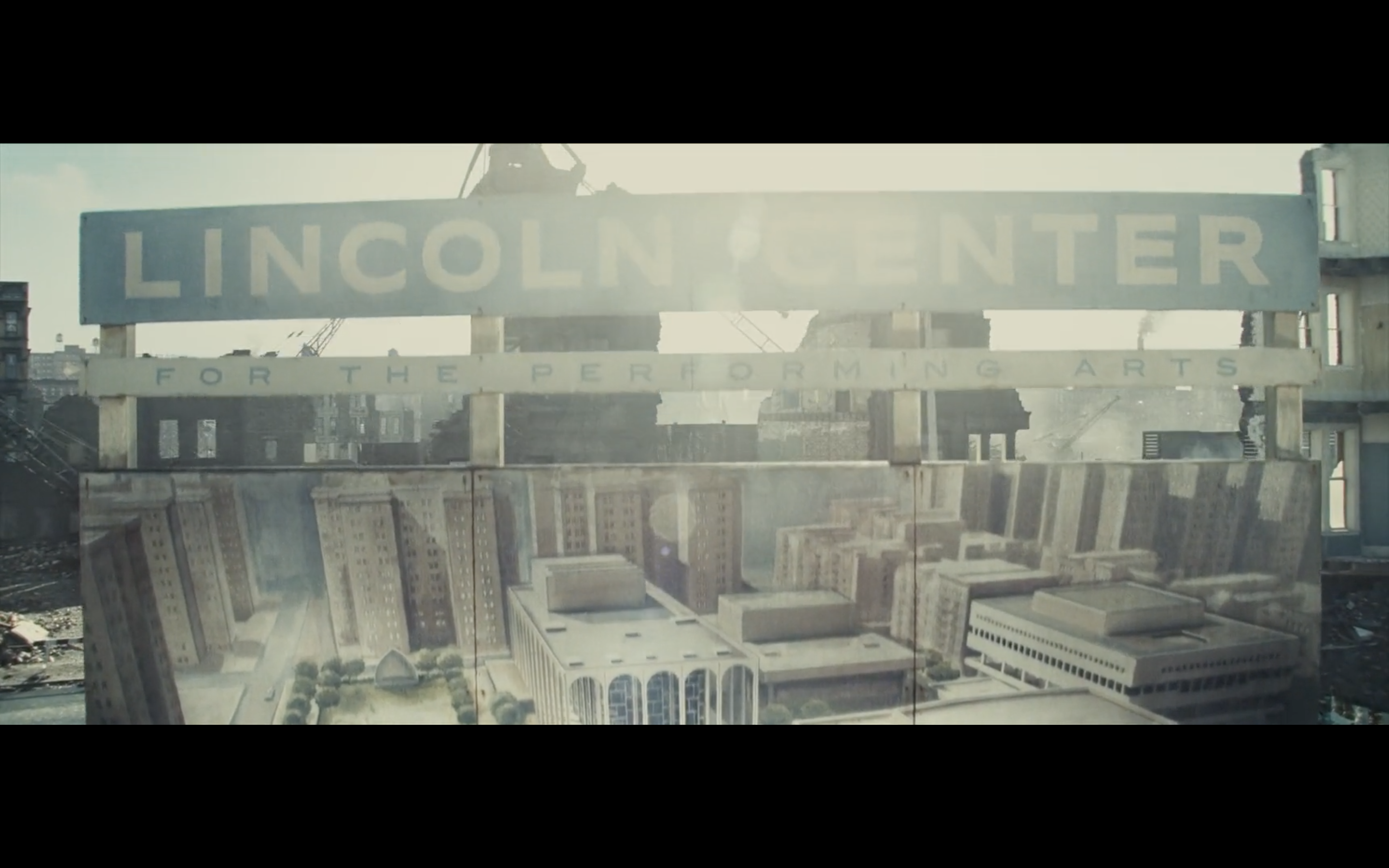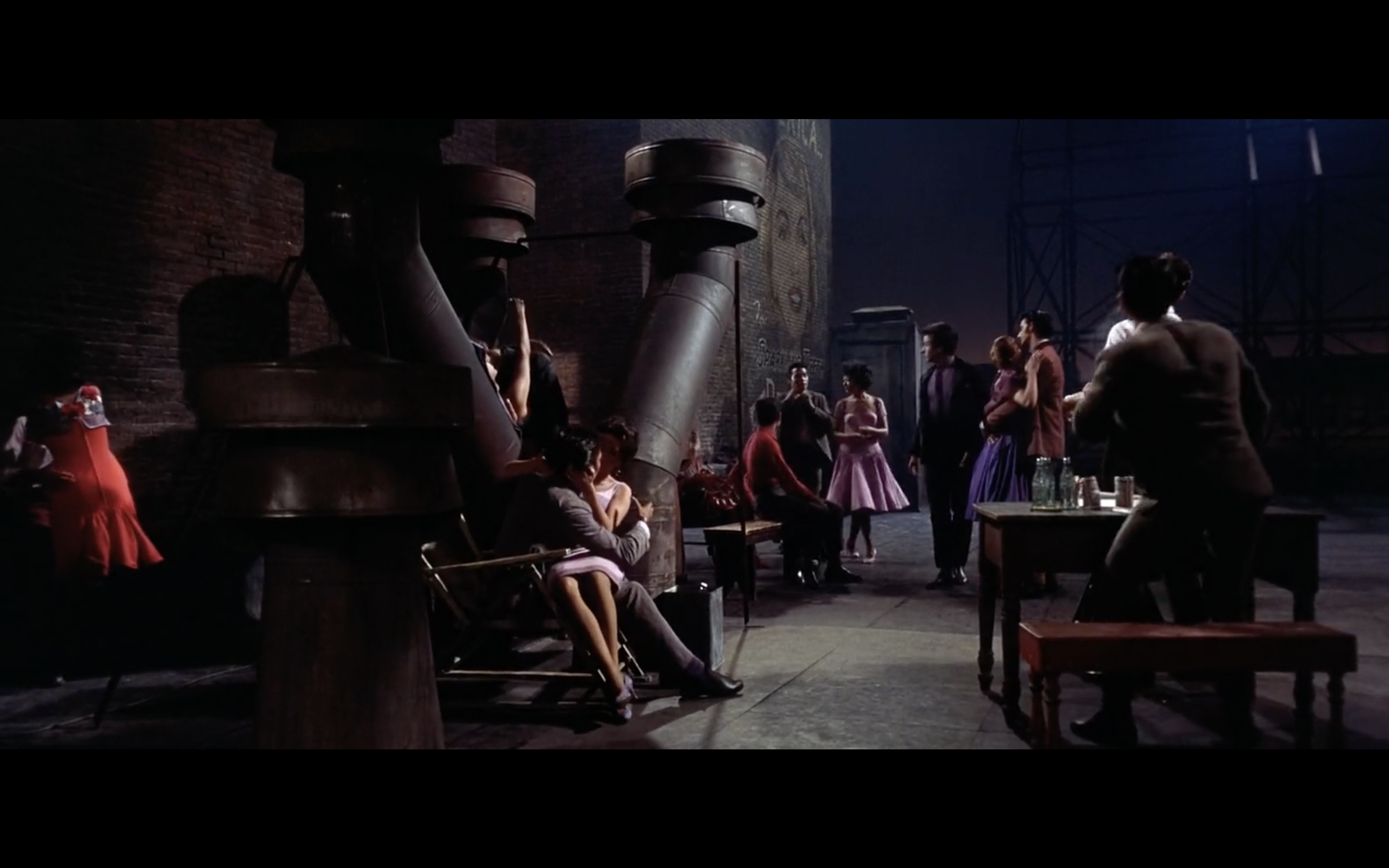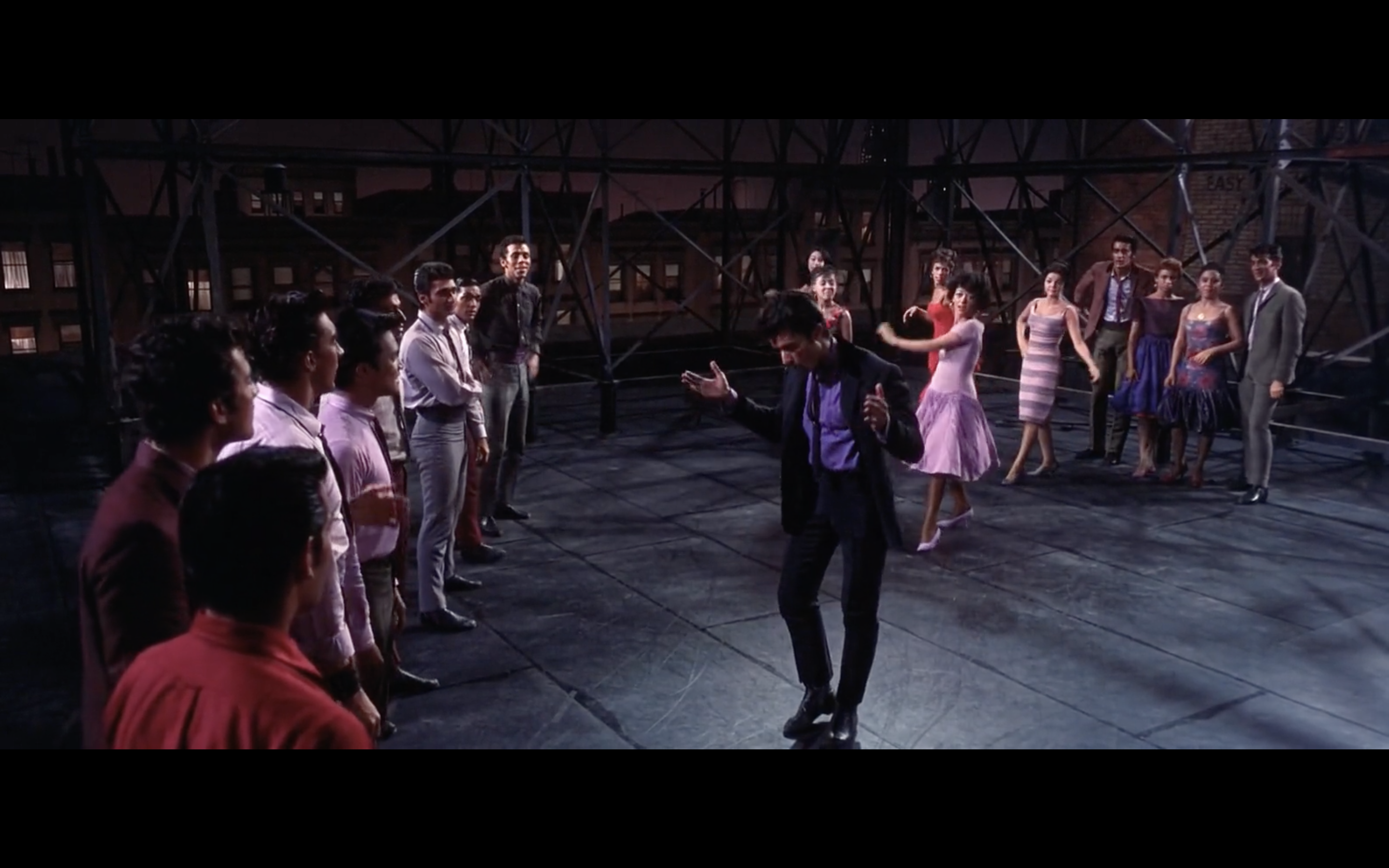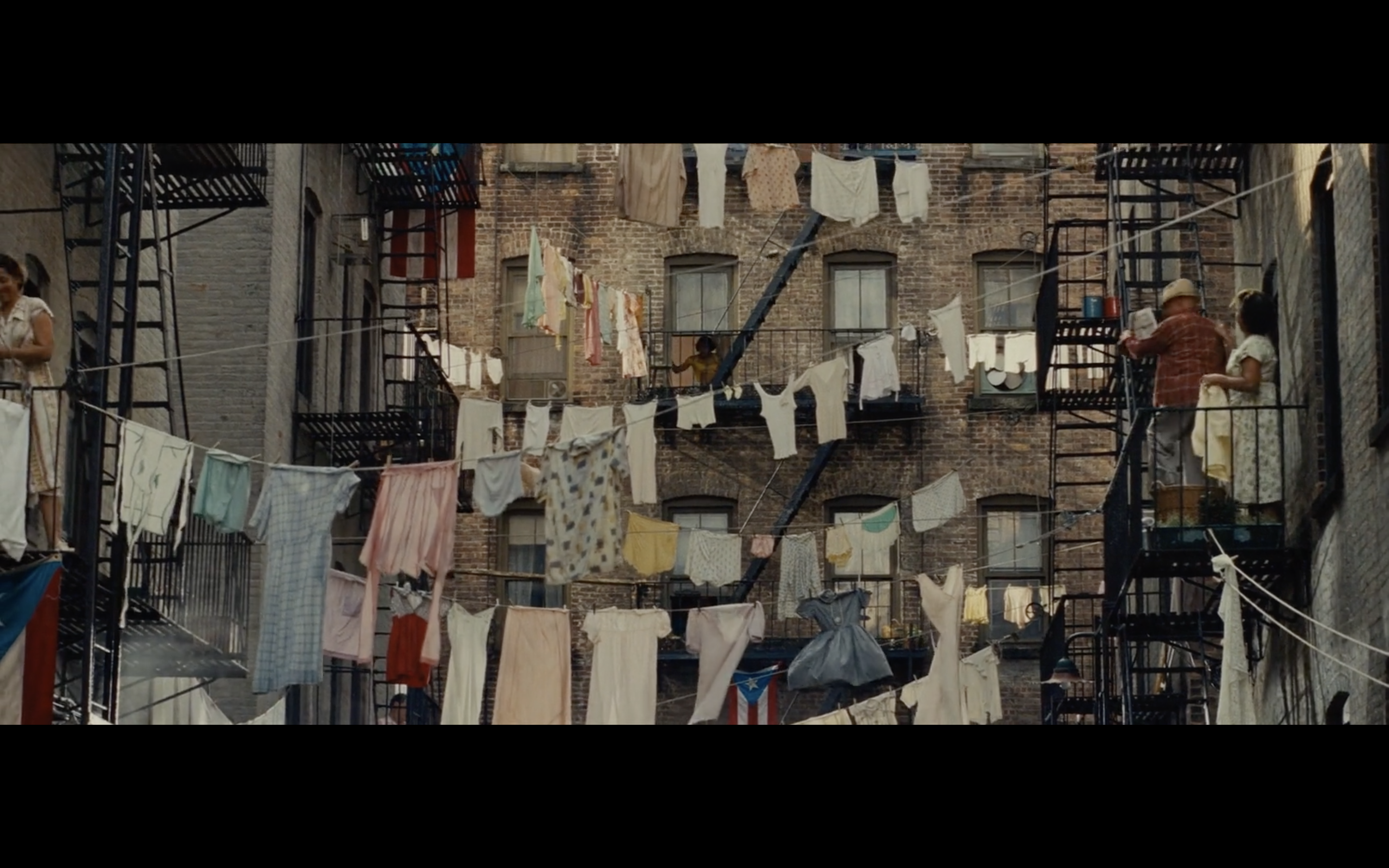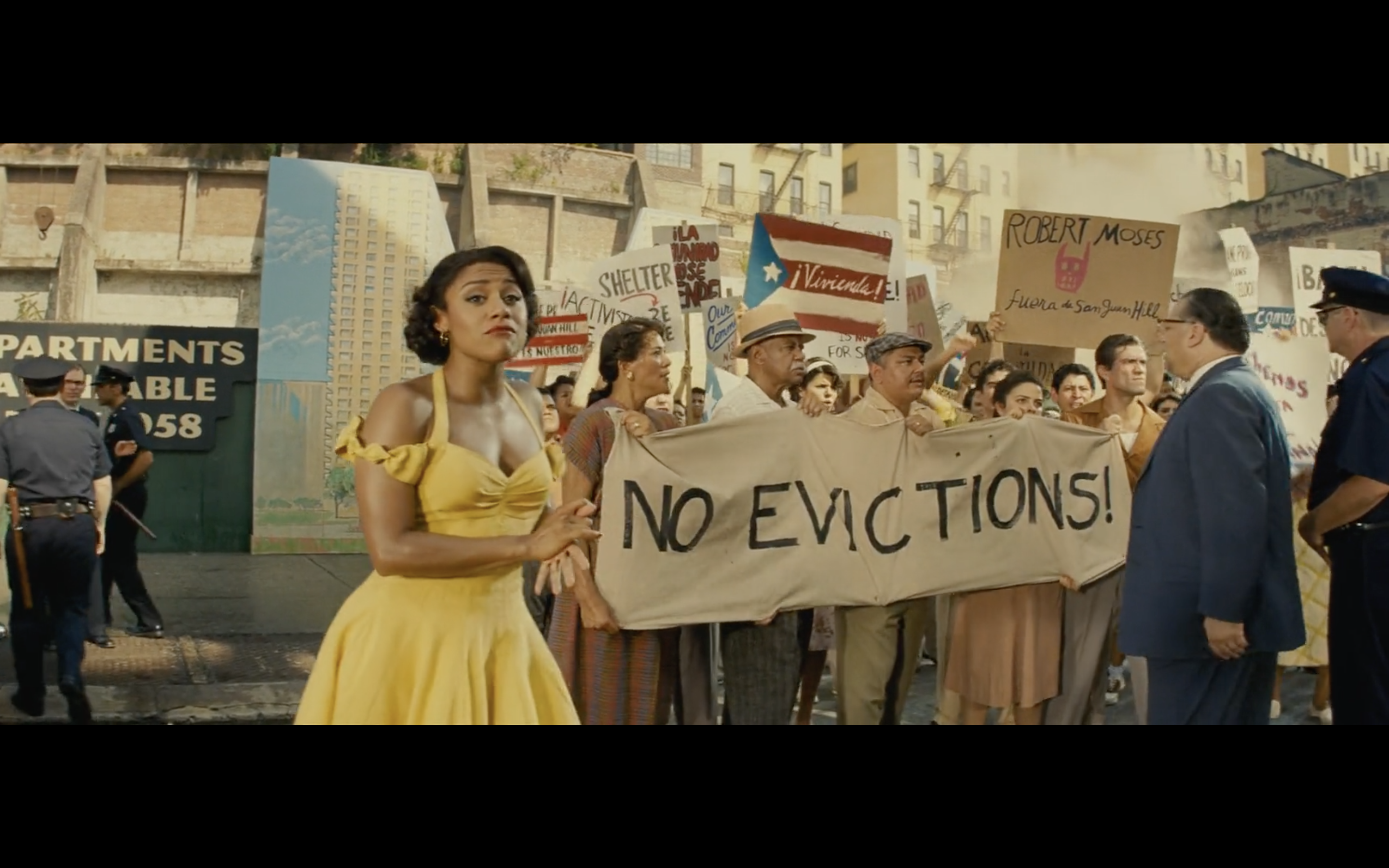« West Side Story » then and now: the representation of Puerto Rican immigrants in the 1961 film and the 2021 remake
Introduction
West Side Story premiered on Broadway in 1957 to critical acclaim, quickly becoming a commercial success. The motion picture industry saw the potential of this story and adapted it to the big screen in 1961. Six decades separate Robert Wise and Jerome Robbins’ classic West Side Story from its 2021 remake directed by Steven Spielberg. The worldwide known plot never changed: in mid-20th century New York City, two rival gangs fight to assert control over the Upper West Side neighborhood. While the Jets are composed of native-born white American youths, the Sharks are formed of Puerto Ricans who moved to the United States to have their share of the American Dream. It is there, under the shadow of Manhattan’s skyscrapers, that Maria (Natalie Wood in 1961/Rachel Zegler in 2021), the sister of Sharks leader Bernardo (George Chakiris/David Alvarez), falls in love with Tony (Richard Beymer/Ansel Elgort), a former member of the Jets. The forbidden romance ignites further conflict between the gangs, culminating in a series of brutal encounters.
In this article, we will examine how the representation of Puerto Rican immigrants evolved from one movie to another, focusing on the geographical, racial and gender aspects of these portrayals. We will first look back at the genesis of West Side Story as a stage musical and the reception of its film adaptations in order to highlight its relevance within the American culture, as theater and cinema can be considered as the major repositories of national fantasies (Negrón-Muntaner, 2000, 95). Then, we will analyze how the dispute between the Sharks and the Jets for their territory is actually a dispute for identity, and how this urban space is depicted in completely different ways in each movie. Finally, we will investigate how Wise and Robbins’ version, despite recognizing the presence of a community that had lived in New York for decades and allowing it to be central in the narrative, thoroughly reproduced the original musical’s characterization of Puerto Ricans, which was based on racist and sexist stereotypes. However, as we will point out, Spielberg’s remake takes significant strides toward rectifying its predecessor’s lack of authenticity and respect, with a more inclusive, gender- and racial-informed approach.
1. A brief West Side (hi)story
In 1949, director and choreographer Jerome Robbins approached playwright Arthur Laurents and composer Leonard Bernstein about a modern-day musical adaptation of William Shakespeare’s Romeo and Juliet. Instead of the feud between the two Veronese elite families Capulets and Montagues, Robbins wanted to use the conflict between Jewish and Catholic communities in New York City as a contemporary equivalent (Negrón-Muntaner, 2000, 89). However, after some thought, they put the then-called East Side Story project on hold for it felt too similar to Anne Nichols’s Abie’s Irish Rose, the longest-running show on Broadway during the 1920s ((In the story, an Irish Catholic girl and a Jewish boy decide to get married despite their families’ disapproval. According to Negrón-Muntaner (2000, 89), Abie’s Irish Rose is read as a national allegory of “how the melting pot successfully created American whites out of a broad spectrum of European ethnicities, immigration histories, and classes”.)).
A new idea emerged six years later thanks to an article published by The Times about a brawl between Latino gangs in San Bernardino, California. Bernstein recalls being at a Beverly Hills pool with Laurents, working on the score of On the Waterfront (1954). “Then, lying next to us on somebody’s abandoned chair was a newspaper headline, ‘GANG FIGHTS.’ We stared at it and then at each other and realized that this – in New York – was it”, recalls Bernstein (qtd. in Negrón-Muntaner, 2000, 90). Stephen Sondheim, then a Broadway newcomer, was uncertain about joining the project because “[He’d] never been that poor and [he’d] never even known a Puerto Rican!” (qtd. in Lee, 2021). His agent told him to see it from a different angle: “They are star-crossed lovers. They are underprivileged and the haves and have-nots have more to do with their psyches than their economics” (qtd. in Lee, 2021).
The musical opened on September 26, 1957, at the Winter Garden Theatre in New York City, and was praised by critics such as The New York Times’ Brooks Atkinson for finding “odd bits of beauty amid the rubbish of the streets” (qtd. in Aggarwal-Schifellite, 2019) or Los Angeles Times’ Albert Goldberg for being “the most serious and uncompromising musical yet to achieve success on the Broadway stage” (qtd. in Lee, 2021). It ran for an initial 732 performances, followed by a national tour, another 249 performances in New York City and a two-year production in London.
The subsequent adaptation to the big screen won ten Oscars, including Best Picture, Best Director and Best Actor and Actress in a Supporting Role (for George Chakiris and Rita Moreno). It is considered one of the greatest American movie musicals of all time, ranking second in the 2006 American Film Institute’s list, right behind Singin’ in the Rain (1952). A box office triumph, it earned more than $44 million worldwide, becoming the highest-grossing musical film of all time until the release of Wise’s The Sound of Music in 1965. On the other hand, Spielberg’s adaptation was deemed a financial failure, grossing $76 million worldwide against a $100 million budget. It got nominated for seven Academy Awards, including Best Picture, but only Ariana DeBose was granted an accolade for her performance as Anita, Bernardo’s Puerto Rican girlfriend, the same role which won Moreno her Oscar ((Sixty years later, Rita Moreno returned to the Sharks-Jets universe in a very special role offered by Spielberg: Valentina, the drugstore owner and a sort of grandmother-figure to Tony.)).
2. A neighborhood about to be razed: immigration and territory
The Upper West Side is not just a setting but an integral element that shapes the themes of immigration and territorial conflict in both films. According to Julia Foulkes, during the 1950s and early 1960s, New York City was flourishing: one could find there the United Nations, Abstract Expressionists, poets, jazz and rock ‘n’ roll musicians, and a multitude of newspapers, magazines, radio shows, and television programs that broadcast its vibrant culture to the world (2016, 8). Simultaneously, “swaths of the city were demolished and rebuilt with urban renewal funds, sprouting public housing projects, private office high-rises, and networks of bridges, roads, and tunnels” (Foulkes, 2016, 8). As for the overall population of the city, although it remained relatively constant in the postwar era, demographic shifts were significant, with “an enormous postwar migration from the island that had ‘nearly doubled’ New York City’s Puerto Rican population in just two years” (Thomas, 2010 qtd. in Valle, 2020).
The west side of Manhattan in particular underwent significant changes under planning commissioner Robert Moses’ watch. In 1955, he declared nearly fifty-three (it would eventually drop to forty-eight) acres across eighteen blocks between 60th and 65th streets, as derelict and therefore eligible for Title 1 funds from the federal government ((As part of the U.S. Housing Act of 1949, Title 1 “provided deep federal subsidies for clearance of slum areas in order to stimulate their reconstruction by private developers” (Ballon, 2007, 94).)) (Foulkes, 2016, 32). This led to the displacement of many low- and middle-income families, as well as Puerto Rican and others immigrant communities of the neighborhood then known as San Juan Hill and now as Lincoln Square. As Foulkes explains, where there once were two- to five-story brownstone buildings, small shops and local businesses, there would soon be the world’s largest performing arts complex, high-rise apartment and office buildings, and a midtown campus for Fordham University (2016, 32-33). Moses saw the poverty in San Juan Hill as an opportunity to erect a completely new neighborhood with modern facilities that would attract wealthier and whiter residents.
Both films use the physical environment of the Upper West Side to highlight the instability and the sense of confinement imposed upon the characters, whose movements are often restricted to a few blocks, symbolizing their limited opportunities and their isolation from the rest of the city. However, in the 1961 version we are not informed of the landscape transformation the Upper West Side is facing. Playwright Arthur Laurents once stated: “I think the reality should be an emotional, not a factual one.... The point is prejudice and that is the background of the plot” (Foulkes, 2016, 63-63). The musical’s connection to the streets relied, for him, in theme, not in a socioeconomic depiction of the environment. Thus, all the playgrounds, basketball courts, brick tenements with rusty balconies we see in the 1961 movie only serve as a stark backdrop to music numbers and fight scenes. The opening sequence itself makes it very clear: Wise and Robbins use aerial shots to travel across New York City in search of the Upper West Side, eventually landing upon a basketball court that resembles any other basketball court in the United States, where the Jets are gathered snapping their fingers.
When we compare this opening sequence to that of the 2021 remake, we understand how the latter put some effort into fixing the inaccuracies presented by the former. Rather than exploring the city with his camera, Spielberg opens his movie with a pile of debris, then tilts up to reveal a demolishing site with a sign that reads “This property purchased by the New York housing authority for slum clearance”. Above the sign and the fence from which it hangs, we follow a huge billboard announcing the new Lincoln Center. Higher up, we catch a few buildings still standing, albeit half-destroyed, and some bulldozers and trucks in full activity. Unlike Wise and Robbins’ more generic establishing shot, the actual seriousness of the situation is set straight by Spielberg: this is a vulnerable place inhabited by vulnerable people.
Trapped in this neighborhood about to be razed, the Sharks and the Jets seem to fight over a piece of land, but this is in fact a “dogged fight to be full citizens, to be embraced as worthy individuals, to define the world they wanted rather than accept the one they were given” (Foulkes, 2016, 8). The Sharks aim to protect a community that was drawn to New York City by the promise of freedom and prosperity, but was only met with discrimination. The 1961 opening sequence shows how the Jets whistle at the Sharks as if they were dogs, using cliché Spanish words to refer to them (“chico”) and constantly telling them to “beat it”. In the 2021 opening sequence, the violence reaches a symbolic level when the Jets vandalize a big Puerto Rican flag painted on a street wall. Meanwhile, as children of white European immigrants – in this case of Polish descent –, the Jets “want to protect their turf not only because it is their territory, but also because they want to keep its whiteness intact” (Davine, 2016, 143). They conform to an “all-American” national identity; still, they are treated as misfits by the authorities, represented in the story by the characters of Lieutenant Schrank (Simon Oakland/Corey Stoll) and Officer Krupke (William Bramley/Brian d'Arcy James). In both films, the “Gee, Officer Krupke” music number illustrates that point: in a mocking tone, the Jets describe themselves as the police and the whole society see them (“Our mothers all are junkies,/Our fathers all are drunks”), trying to prove that there is more to them than that (“We ain’t no delinquents,/We’re misunderstood./Deep down inside us there is good!”). Both the Jets and the Sharks are therefore engaged in a quest to belong in an ever-changing city.
3. From brownface to inclusive casting, from submissive to independent women: race and gender roles
Spielberg himself confessed that remaking West Side Story in the 21st century required some major improvements – the biggest one being related to casting Latino actors as Latino characters. Twenty members of the new cast are Puerto Rican or of Puerto Rican descent, including Josh Andrés Rivera, who plays Bernardo’s best friend and Maria’s arranged fiancée Chino, as well as Ariana DeBose (of African-Puerto Rican descent on her father’s side). “The reason we’ve hired so many Puerto Rican singers and dancers and actors is so they can help guide us to represent Puerto Rico in a way that will make all of you and all of us proud”, Spielberg told a group of professors and students during a surprise visit to the University of Puerto Rico, in San Juan, in 2018 (qtd. in Lee, 2021). Despite not having Puerto Rican roots, Rachel Zegler is of Colombian descent on her mother’s side, while David Alvarez was born to Cuban parents. This allowed the 2021 adaptation to have a large part of dialogue in Spanish and without subtitles. “If I subtitled the Spanish, I’d simply be doubling down on the English and giving English the power over the Spanish. This was not going to happen in this film, I needed to respect the language enough not to subtitle it”, Spielberg told IGN (qtd. in Lee, 2021).
On the contrary, in the 1961 adaptation the vast majority of Puerto Rican characters were played by white American actors, such as Natalie Wood (of Russian and Ukrainian descent) and George Chakiris (born to Greek immigrants from Turkey). Chino was played by Jose De Vega, whose mother was Colombian, but the only one who was indeed Latina was Rita Moreno, born in Humacao, Puerto Rico. Yet, for the purpose of the film, her skin was darkened with makeup. Moreno questioned the makeup artist on set about the practice: “We are many colors”, she recalled in a 2019 interview with the Associated Press (qtd. in Lee, 2021). The makeup artist then accused her of being racist. “I was so stunned that I didn’t say anything. I didn’t know what to say. That’s really also how little people know about Puerto Ricans”, Moreno added (qtd. in Lee, 2021). The brownface also applied to Wood’s Maria, Chakiris’ Bernardo and to all the other white actors in Puerto Rican roles, literally painting this community as foreigners, exotic Others. It is evident that Wise and Robbins stuck to the original project’s problematic essence, which stemmed from the perception that four white American men (Robbins, Laurents, Bernstein and Sondheim) had of Puerto Ricans: dark skin, thick accent, and a tendency toward violence.
If skin color is one of the ways in which the 1961 film caricatures Puerto Ricans, so are sexist stereotypes. Women are either virginal and childlike, or sexual and fiery (Negrón-Muntaner, 2000, 83). Maria fits in the first category as the idealized vision of femininity with her innocence and longing for romantic love. Dressed in white as the Virgin Mary, she is largely defined by her relationships with male characters, particularly Tony and Bernardo. Even though she works at the bridal shop with Anita, we mostly see her behind her balcony railing, where she and Tony have their secret encounters. This reinforces her confinement to the domestic sphere, under the surveillance of her parents (whom she always mentions, but we never get to see). As for Anita, she fits better in the second category. Besides having a job, and hence being independent, she is self-confident enough to sport splashy and sassy dresses, and to flash some incredible dance moves around the Upper West Side. She is definitely not embarrassed to fulfill her sexual desires, as she herself professes in the “Tonight (Quintet)” number (“Anita’s gonna get her kicks/Tonight/We’ll have our private little mix/Tonight/He’ll walk in hot and tired,/So what?/Don’t matter if he’s tired,/As long as he’s hot/Tonight”). And, as we will point out in the commentary about the “America” sequence, she is not afraid of speaking her mind, even if it crosses Bernardo.
On the other hand, Spielberg’s remake shifts toward more nuanced and gender sensible portrayals of women. Zegler’s Maria is given more agency in her relationship with Tony: she is the one who makes the first move on him, during the dance at the gym, catching him by surprise with a kiss. In the 1961 film, the two of them slowly lean in and share a tender, passionate kiss. DeBose’s Anita is no longer an employee of a bridal shop, but an entrepreneur: she now runs the business on her own, from the apartment she shares with Bernardo and Maria (who doesn’t live with her parents in this version). “I work my fingers raw mending pants and hemming neckties so that I can earn enough money to pay other girls to sew for me, so that someday I can rent a shop of my own”, Anita tells Bernardo after he tries to convince her to go back to Puerto Rico and have “six babies”. Toward the end of the movie, when she is tasked with carrying a message from Maria to Tony, who is hidden in Valentina’s drugstore basement, we find what must be the greatest example of how Spielberg addresses gender issues with a special attention. In a staggering twist, Anita is surrounded by the Jets inside the drugstore and gets verbally assaulted by them, including Jets leader Riff’s girlfriend, Graziella (Paloma Garcia-Lee), and her friend Velma (Maddie Ziegler). They are the only other women in the room. If at first Graziella contributes to the verbal attack, she stops the minute she realizes the men’s intention to gang-rape Anita. Both Graziella and Velma get kicked out of the store under protest, watching powerlessly through the glass of the front door as the Jets keep harassing the Puerto Rican girl. At the end, it is another woman, Valentina, who saves Anita.
Commented extract
In both film adaptations, the famous number “America”, sung by Anita, her Puerto Rican girlfriends, Bernardo and the Sharks, is built up as a male-female quarrel over the assimilation of Puerto Ricans in the United States. According to Sandoval-Sánchez (qtd. in Davine, 2016, 142), “Anita takes an assimilationist stance, rejecting her country of origin and praising life in America, while Bernardo takes an anti-assimilationist one”, expressing all the racism that the Puerto Rican immigrants have to endure in that country. If Anita and her chorus girls rave over skyscrapers, Cadillacs, credit cards and washing machine, Bernardo and the Sharks remind them that Puerto Rican immigrants live crowded together in a single room, that they don’t have much to keep clean, and that they are charged more when they want to purchase something. “Life can be bright in America”, Anita sings, to which Bernardo and the Sharks reply, “If you can fight in America.” “Life is all right in America”, Anita and her girls insist. “If you’re all-white in America”, the Sharks retort.
If the lyrics remain almost untouched from one film to another, there is nonetheless an interesting change in the first verse of the 2021 “America” sequence – an action that Wise and Robbins had also allowed themselves to take when adapting the stage musical to the big screen. The Broadway version of “America” begins with Rosalia, a minor character from the neighborhood, singing about Puerto Rico and its delights, until Anita repeats what she said, but with a more pessimistic perspective on their homeland:
| ROSALIA (1957) | ANITA (1957) |
| “Puerto Rico, | “Puerto Rico… |
| You lovely island… | You ugly island… |
| Island of tropical breezes. | Island of tropic diseases. |
| Always the pineapples growing, | Always the hurricanes blowing, |
| Always the coffee blossoms blowing…” | Always the population growing... |
| And the money owing, | |
| And the babies crying, | |
| And the bullets flying.” |
In the 1961 movie, Rosalia’s lines are left aside, and it is Anita who starts the song. There is no more allusion to firearms, violence or illness; still, Anita has nothing good to say about her own country. In Spielberg’s adaptation, the opening is not a reworking: “We took Rosalia’s hymn to Puerto Rico from the original musical, and then added Anita’s lines from the original and the movie”, screenwriter Tony Kushner told Time (Chow, 2021). The result is an amalgam of the Broadway and the 1961 versions (in bold), with the three final verses now sung by the chorus girls instead of Anita:
| ANITA (1961) | ANITA (2021) |
| “Puerto Rico | “Puerto Rico |
| My heart’s devotion | You lovely island |
| Let it sink back in the ocean | Island of tropical breezes |
| Always the hurricanes blowing | Always the pineapples growing |
| Always the population growing | Always the coffee blossoms blowing |
| And the money owing | CHORUS GIRLS (2021) |
| And the sunlight streaming | And the money owing |
| And the natives steaming.” | And the babies crying |
| And the people trying.” |
The 2021 lyrics are much less derogatory than the 1961 version, which exemplifies Spielberg’s aim to present a less polemical portrayal of Puerto Rico.
As for the settings, they change considerably from one film to another. While Wise and Robbins’ iconic sequence takes place entirely on a rooftop, with little geographical elements that could set apart the Upper West Side, the 2021 remake has its “America” number spread throughout the whole neighborhood. It begins among brick tenements dotted with Puerto Rican flags; Ariana DeBose’s Anita emerges from one of the balconies and burst into the song while collecting her clothes from outdoor washing lines. When Anita sings “Lots of new housing with more space,” she is now standing next to a small demonstration in front of a construction site from which a sleek new building will rise. “Lots of doors slamming in our face”, the Puerto Rican protestors cry out, holding a “No evictions” sign and another one that reads “Robert Moses, fuera de San Juan Hill”.
Even though Bernardo breaks down all of Anita’s assimilationist points, Sandoval-Sánchez believes that these opposite statements are ultimately obliterated by the song’s “patriotic pro-U.S. propaganda” (qtd. in Davine, 2016, 142). What is startling is that, in the 1961 film, such assimilation comes from the only Puerto Rican actor (Rita Moreno), and that the “brownface” Bernardo is the one who criticizes the United States. Moreover, the fact that the soundtrack is an American fusion of Latin American rhythms – “the Sharks [are] dancing a Spanish-from-Spain paso doble mishmashed with whitewashed showbiz jazz” (Valle, 2020) – undermines the song’s social commentary and irony, mesmerizing instead the audience alongside high-level dance performances. “‘America’ is one of such musical numbers that accentuates the Puerto Ricans as objects of spectacle”, Davine sums up (2016, 142).
Conclusion
Indeed, as Negrón-Muntaner writes in a 2021 article about remaking West Side Story, the 1961 film “was the first major – and still the most widely seen and exported – U.S. cultural product to recognize Puerto Ricans as a distinct Latino group in the United States with specific physical characteristics (brown, dark-haired, svelte) and personality traits (loud, sexy, colorful)”. However, Wise and Robbins did so by maintaining the original Broadway musical’s representation of Puerto Ricans as eccentric invaders or intruders of America, men being portrayed as criminals and women as victims. Spielberg really tried to avoid these racist and sexist stereotypes in his version, and to make an authentic Latino production out of it, with actual Latino performers and no more brownface. He succeeds not only in acknowledging the impact of urban renewal projects on immigrant communities of the Upper West Side, but also in tackling gender roles with a complexity that resonates with contemporary audiences. Still, no matter how many mistakes were repaired by Spielberg, it remains a story created by four white American men based on what they thought Puerto Ricans were, that is, “inherently musical and performative subjects, ready to wear their sexualized identity for a white audience at the drop of a hat” (Negrón-Muntaner, 2000, 85). Besides, at a time when the movie industry is being reshaped to be more diverse, allocating a $100 million budget for a remake conducted by a white American man shows that there is still a long way to go when it comes to letting Latinos tell their own stories in Hollywood.
Notes
Bibliography
AGGARWAL-SCHIFELLITE, Manisha. “‘West Side Story’ Explores Racial, Ethnic, Political Complications”, Harvard Gazette, 12 November 2019, news.harvard.edu/gazette/story/2019/11/west-side-story-explores-racial-ethnic-political-complications/.
BALLON, Hillary and JAKCSON, Kenneth T. 2007. Robert Moses and the Modern City: The Transformation of New York. New York: W.W. Norton & Company.
CHOW, Andrew R. “How Tony Kushner and His Collaborators Brought West Side Story Into the 21st Century”, Time, 09 December 2021, https://time.com/6126692/tony-kushner-west-side-story/.
DAVINE, Lauren. 2016. “‘Could We Not Dye It Red at Least?’: Color and Race in West Side Story”, Journal of Popular Film and Television, volume 44, nº3, pp.139-149, https://filmcolors.org/wp-content/uploads/2013/05/Davine_WestSideStory_JournalOfPopularFilmAndTelevision_2016.pdf.
FOULKES, Julia L. 2016. A place for us: “West Side Story” and New York. Chicago; London: The University of Chicago Press.
LEE, Ashley. “‘West Side Story’ Can Never Be Authentic, Spielberg or Not”, Los Angeles Times, 12 December 2021, https://www.latimes.com/entertainment-arts/movies/story/2021-12-12/west-side-story-puerto-rico-cultural-authenticity.
NEGRÓN-MUNTANER, Frances. 2000. “Feeling Pretty: West Side Story and Puerto Rican Identity Discourses”, Social Text 63, volume 18, nº2, pp.83-106, https://muse.jhu.edu/pub/4/article/31870/summary.
NEGRÓN-MUNTANER, Frances. “West Side Story 60 Years Later — The Time for Us is Now”, Women’s Media Center, 22 November 2021, https://womensmediacenter.com/idare/west-side-story-60-years-later.
ROBBINS, Jerome and WISE, Robert. 1961. West Side Story. United States: Mirisch Pictures & Seven Arts Productions.
SPIELBERG, Steven. 2021. West Side Story. United States: Amblin Entertainment & TSG Entertainment.
VALLE, Carina De. “Let ‘West Side Story’ and Its Stereotypes Die”, The New York Times, 24 February 2020, www.nytimes.com/2020/02/24/opinion/west-side-story-broadway.html.
Cette fiche a été rédigée dans le cadre d'un stage à l'ENS de Lyon.
Pour citer cette ressource :
Lucas Leone, West Side Story then and now: the representation of Puerto Rican immigrants in the 1961 film and the 2021 remake, La Clé des Langues [en ligne], Lyon, ENS de LYON/DGESCO (ISSN 2107-7029), juin 2024. Consulté le 17/12/2025. URL: https://cle.ens-lyon.fr/anglais/arts/cinema/west-side-story-then-and-now-the-representation-of-puerto-rican-immigrants-in-the-1961-film-and-the-2021-remake



 Activer le mode zen
Activer le mode zen